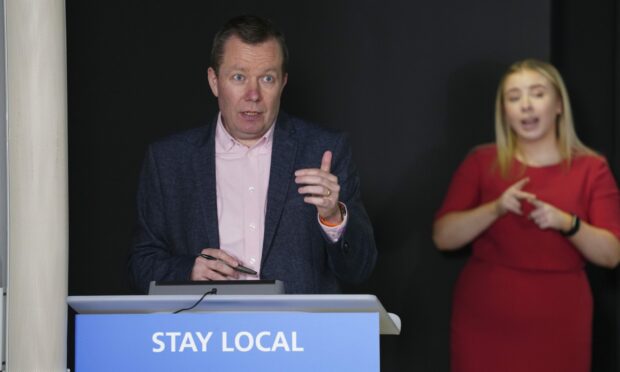Scotland now has the highest Covid rates in Europe – with Tayside the most infected region in the continent.
However, Dundee figures have taken a dip over the weekend.
The Scottish figures have been linked to people gathering to watch Euro 2020.
World Health Organization (WHO) figures show Tayside has the highest rate in Europe, with Fife also in the top 10.
Scotland’s clinical director, Professor Jason Leitch, said cases linked to people gathering to watch Euro 2020 matches were “part of the problem”.
He said: “Scotland being out [of the Euros] is very, very unfortunate from a sporting perspective, but probably better from a Covid perspective.”
Tayside has the highest rate
New figures show NHS Tayside has the highest infection rate in Europe, with 1,146 positive cases per 100,000 people.
Dundee is still in the midst of an outbreak, with the worst positivity rate in the UK, but this reduced over the weekend for the first time in weeks.
There were 906.1 positive cases per 100,000 people in the city on Monday, down slightly from 914.1 on Friday.
Dundee rates finally in decline
Dundee’s seven day case-rate has seen a steep rise over the last two months, with rates now finally in decline.
The number of daily new cases has also decreased from 222 on Friday to 136 on Monday.
There were no new deaths recorded in Scotland on Monday.
Angus had 495.7 cases per 100,000 and recorded 65 new cases on Monday, while Perth and Kinross had 557.4 cases per 100,000 and recorded 75 new cases.
Fife had 470.3 cases per 100,000 on Monday and recorded 156 new cases.
Across Scotland, the number of new daily cases has been decreasing over the weekend after a record number of 4,234 new Scottish cases were recorded on Thursday.
On Monday 2,372 new cases of Covid were reported in Scotland, while 2,726 were recorded on Sunday.
There were 338 people in hospital with Covid in Scotland on Monday with 30 people in ICU.
In Tayside there were 48 people in hospital with Covid and 11 people in hospital in Fife.
Six Scottish health boards are among the top 10 worst-hit regions in Europe, according to WHO figures.
As well as Tayside and Fife, Lothian, Greater Glasgow and Clyde, Lanarkshire and Ayrshire and Arran health boards are also in the top 10, along with north-east and north-west England.
The only areas in the table outside the UK are Nur-Sultan City in Kazakhstan and the Russian Federation’s capital, Moscow.
Lack of ‘natural immunity’
As well as football gatherings, Professor Leitch has blamed a lack of “natural immunity” in the Scottish population for the high Covid rates.
He also said Scotland had been hit by the infectious Delta variant becoming “seeded” in Glasgow.
Scotland highest numbers in UK
Professor Leitch told BBC Radio’s Good Morning Scotland programme the fundamental reason for the figures was the spread of the Delta variant.
“It’s got seeded into our biggest, dense city in Glasgow and we’ve got less natural immunity because we haven’t been at the top of this league table throughout the pandemic,” he said.
“It’s not a league table I want to top and I want to get us off there as quickly as we possibly can.”
‘Big wave’ coming in Europe
He warned a “big wave” of Covid infections, fuelled by the Delta strain, was likely to hit other parts of Europe in the next few weeks.
But Professor Leitch added that the Scottish government was “relatively optimistic” that hospital admissions and deaths were not rising at the same rates they were earlier in the pandemic because of the protection offered by vaccination.
“We have to watch the translation of those cases into hospitalisations,” he said.
“Hospitalisations are now going up a little, but they’re not at the levels they were in the first and second waves.
“Intensive care is stable – [there are] really low numbers of Covid cases in intensive care.”
‘Out of control spread’
Scottish Labour leader Anas Sarwar has called for the gap between first and second vaccinations to be halved to four weeks.
He said that would help deal with the “out of control” spread of coronavirus.
Mr Sarwar said guidance from the Medicines and Healthcare products Regulatory Agency (MHRA) suggests that vaccines can be effective when the two doses are administered just four weeks apart.
But a spokesman for Health Secretary Humza Yousaf said an eight-week gap is “optimal”, according to advice from the Joint Committee on Vaccination and Immunisation (JCVI) and “reducing that below eight weeks would compromise the effectiveness of the vaccine and how long that effect lasts”.
He added: “We are progressing the final stages of our successful vaccine roll-out as quickly as we can.
“This is limited by supply, we can only give Pfizer to younger age groups, in addition, constraints on supply affect the pool of those who had their first dose eight weeks previously.”


